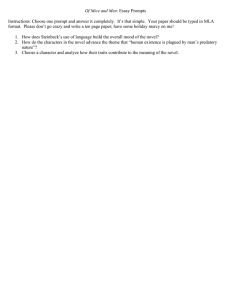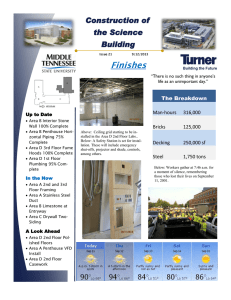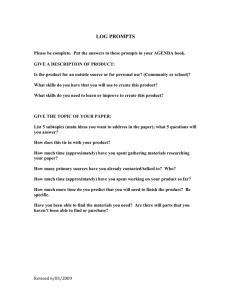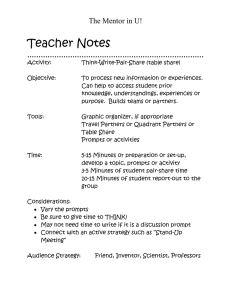Bloom`s Taxonomy and Costa`s Levels of Questioning Prompts and
advertisement
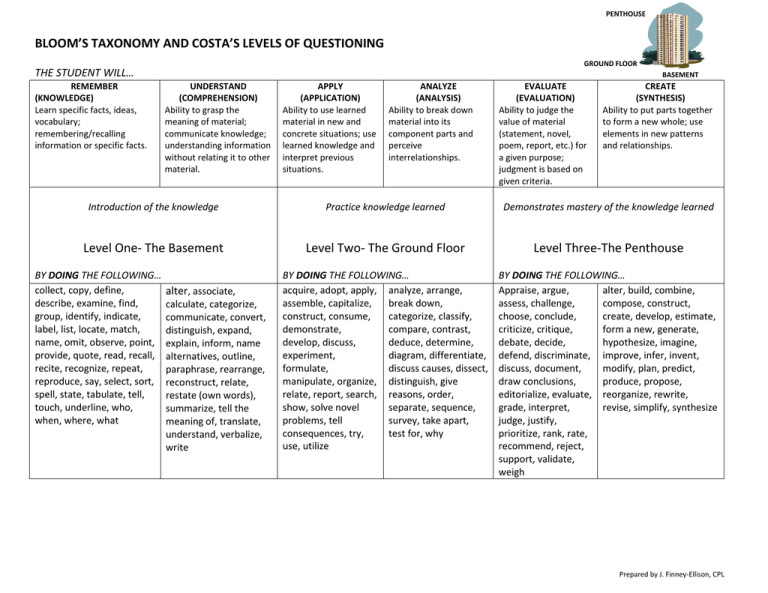
PENTHOUSE BLOOM’S TAXONOMY AND COSTA’S LEVELS OF QUESTIONING GROUND FLOOR THE STUDENT WILL… REMEMBER (KNOWLEDGE) Learn specific facts, ideas, vocabulary; remembering/recalling information or specific facts. BASEMENT UNDERSTAND (COMPREHENSION) Ability to grasp the meaning of material; communicate knowledge; understanding information without relating it to other material. APPLY (APPLICATION) Ability to use learned material in new and concrete situations; use learned knowledge and interpret previous situations. ANALYZE (ANALYSIS) Ability to break down material into its component parts and perceive interrelationships. EVALUATE (EVALUATION) Ability to judge the value of material (statement, novel, poem, report, etc.) for a given purpose; judgment is based on given criteria. CREATE (SYNTHESIS) Ability to put parts together to form a new whole; use elements in new patterns and relationships. Introduction of the knowledge Practice knowledge learned Demonstrates mastery of the knowledge learned Level One- The Basement Level Two- The Ground Floor Level Three-The Penthouse BY DOING THE FOLLOWING… acquire, adopt, apply, analyze, arrange, assemble, capitalize, break down, construct, consume, categorize, classify, demonstrate, compare, contrast, develop, discuss, deduce, determine, experiment, diagram, differentiate, formulate, discuss causes, dissect, manipulate, organize, distinguish, give relate, report, search, reasons, order, show, solve novel separate, sequence, problems, tell survey, take apart, consequences, try, test for, why use, utilize BY DOING THE FOLLOWING… Appraise, argue, alter, build, combine, assess, challenge, compose, construct, choose, conclude, create, develop, estimate, criticize, critique, form a new, generate, debate, decide, hypothesize, imagine, defend, discriminate, improve, infer, invent, discuss, document, modify, plan, predict, draw conclusions, produce, propose, editorialize, evaluate, reorganize, rewrite, grade, interpret, revise, simplify, synthesize judge, justify, prioritize, rank, rate, recommend, reject, support, validate, weigh BY DOING THE FOLLOWING… collect, copy, define, describe, examine, find, group, identify, indicate, label, list, locate, match, name, omit, observe, point, provide, quote, read, recall, recite, recognize, repeat, reproduce, say, select, sort, spell, state, tabulate, tell, touch, underline, who, when, where, what alter, associate, calculate, categorize, communicate, convert, distinguish, expand, explain, inform, name alternatives, outline, paraphrase, rearrange, reconstruct, relate, restate (own words), summarize, tell the meaning of, translate, understand, verbalize, write Prepared by J. Finney-Ellison, CPL PENTHOUSE BLOOM’S TAXONOMY AND COSTA’S LEVELS OF QUESTIONING WITH QUESTION PROMPTS GROUND FLOOR THE STUDENT WILL… REMEMBER (KNOWLEDGE) Learn specific facts, ideas, vocabulary; remembering/recalling information or specific facts. BASEMENT UNDERSTAND (COMPREHENSION) Ability to grasp the meaning of material; communicate knowledge; understanding information without relating it to other material. APPLY (APPLICATION) Ability to use learned material in new and concrete situations; use learned knowledge and interpret previous situations. ANALYZE (ANALYSIS) Ability to break down material into its component parts and perceive interrelationships. EVALUATE (EVALUATION) Ability to judge the value of material (statement, novel, poem, report, etc.) for a given purpose; judgment is based on given criteria. CREATE (SYNTHESIS) Ability to put parts together to form a new whole; use elements in new patterns and relationships. Introduction of the knowledge Practice knowledge learned Demonstrates mastery of the knowledge learned Level One- The Basement Level Two- The Ground Floor Level Three-The Penthouse BY BEING ASKED OR PROMPTED TO ANSWER… PROMPTS TO PROMPTS TO PROMOTE THIS TYPE OF PROMOTE THIS TYPE THINKING OF THINKING Where is… Tell me in your own What did… words… Who was… What does it mean… When did… Give me an example How many… of… Locate it in the Describe what… story/text/passage… Illustrate the part of the Point to the… story that… Make a map of… What is the main idea of… BY BEING ASKED OR PROMPTED TO ANSWER… PROMPTS TO PROMPTS TO PROMOTE THIS TYPE PROMOTE THIS TYPE OF THINKING OF THINKING What would happen What things would to you if… you have used… Would you have done What other ways the same as… could… If you were there, What things are would you… similar/different? How would you solve What part of this the problem… story/event was the In the library, find most exciting? information about… What things couldn’t have happened in real life? What kind of person is… What caused ____to act the way s/he did? BY BEING ASKED OR PROMPTED TO ANSWER… PROMPTS TO PROMPTS TO PROMOTE THIS TYPE PROMOTE THIS TYPE OF THINKING OF THINKING Would you recommend What would it be like this book? Why or why if… not? What would it be like Select the best… to live… Why is it the best? Design a… What do you think will Pretend you are a… happen to… What would have Why do you think that? happened if… Could this story /event Why/why not? really have happened? Use your imagination Which character would to create a you like most to meet? picture/image of… Was_____good or bad? Add a new item on Why? your own… Did you like the story? Tell/write a different Why? ending… Prepared by J. Finney-Ellison, CPL PENTHOUSE BLOOM’S TAXONOMY AND COSTA’S LEVELS OF QUESTIONING WITH TASK EXAMPLES GROUND FLOOR THE STUDENT WILL… REMEMBER (KNOWLEDGE) Learn specific facts, ideas, vocabulary; remembering/recalling information or specific facts. BASEMENT UNDERSTAND (COMPREHENSION) Ability to grasp the meaning of material; communicate knowledge; understanding information without relating it to other material. APPLY (APPLICATION) Ability to use learned material in new and concrete situations; use learned knowledge and interpret previous situations. ANALYZE (ANALYSIS) Ability to break down material into its component parts and perceive interrelationships. EVALUATE (EVALUATION) Ability to judge the value of material (statement, novel, poem, report, etc.) for a given purpose; judgment is based on given criteria. CREATE (SYNTHESIS) Ability to put parts together to form a new whole; use elements in new patterns and relationships. Introduction of the knowledge Practice knowledge learned Demonstrates mastery of the knowledge learned Level One- The Basement Level Two- The Ground Floor Level Three-The Penthouse EXAMPLES OF THIS… Identify frogs in a diagram of different kinds of amphibians. Write multiplication facts. Answer a true-false question. Name three 19thcentury women authors. Find an isosceles triangle in your house. Reproduce the chemical formula for carbon tetrachloride. Translate a story problem into an algebraic equation. Draw a parallelogram. Make up a title for a short story. Explain how the heart is like a pump. Label numbers odd or even. Compare Gandhi to a present-day leader. Name a mammal that lives in our region/area. EXAMPLES OF THIS… Add a column of two-digit numbers. Proofread a piece of writing. Create a budget. Design an experiment to see how plants grow in different kinds of soil. List the important information in a word problem and cross out the unimportant information. Draw a diagram showing the major and minor characters / persons in a novel /historical event. Determine a character’s motivation in a story. Make a diagram showing the way plants and animals interact. EXAMPLES OF THIS… Judge the arguments or evidence pieces for and against ________. Choose the best method for solving a math problem. Review a project to see if all steps were taken. Judge how well a project meets rubric criteria. Generate hypotheses to explain why plants need sunshine. Build a habitat for a _______. Put on a play based on a chapter from a novel. Given a list of criteria, list some options for nutritious lunch menus. Write a journal entry from the point of view of _________, Prepared by J. Finney-Ellison, CPL

